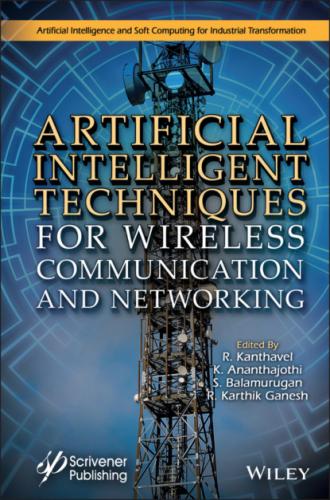4. Aljumaily, M., AI in 5G and Beyond Networks, Presentation, https://www.researchgate.net/publication/342787463_AI_in_5G_and_Beyond_Networks, 2020.
5. Arjoune, Y. and Faruque, S., Artificial Intelligence for 5G Wireless Systems: Opportunities, Challenges, and Future Research Direction. Semantic Scholar, https://doi.org/10.1109/CCWC47524.2020.9031117,1023–1028, 2020.
6. Bajaj, A., Tamanna, Sangwan, O., SMART 5G: Artificial Intelligence Empowered 5G Networks, Conference: 2nd National Seminar on “Design of 5G Mobile Networks Using Soft Computing Techniques”, Guru Jambheshwar University of Science and Technology, Hisar, Haryana, March 2019.
7. Ge, X., Thompson, J., Li, Y., Liu, X., Zhang, W., Chen, T., Applications of Artificial Intelligence in Wireless Communications. IEEE Commun. Mag., 57, 12–13, 2019.
8. Goyal, D., Balamurugan, S., Peng, S.-L., Verma, O.P., Design and Analysis of Security Protocol for Communication, John Wiley & Sons, Inc., Bridgewater, NJ, 2020.
9. Haider, N., Baig, M.Z., Imran, M., Artificial Intelligence and Machine Learning in 5G Network Security: Opportunities, advantages, and future research trends, 2020.
10. Javaid, N., Sher, A., Nasir, H., Guizani, N., Intelligence in IoT-Based 5G Networks: Opportunities and Challenges. IEEE Commun. Mag., 56, 94–100, 2018.
11. Kilinc, C., Sun, C., Marina, M., 5G Development: Automation and the Role of Artificial Intelligence, Wiley online Library, https://onlinelibrary.wiley.com/doi/10.1002/9781119471509.w5GRef128, 2020.
12. Li, R., Zhifeng, Z., Zhou, X., Ding, G., Chen, Y., Zhongyao, W., Zhang, H., Intelligent 5G: When Cellular Networks Meet Artificial Intelligence. IEEE Wireless Commun., 2–10, 2017. Published in: https://ieeexplore.ieee.org/xpl/RecentIssue.jsp?punumber=7742 IEEE Wireless Communications (Volume: 24, https://ieeexplore.ieee.org/xpl/tocresult.jsp?isnumber=8088405 (Issue: 5, October 2017).
13. Morocho-Cayamcela, M.E. and Lim, W., Artificial Intelligence in 5G Technology: A Survey. Conference, 860–865, Oct. 2018.
14. Pérez-Romero, J., Sallent, O., Ferrus, R., Agusti, R., Artificial Intelligence-based 5G network capacity planning and operation, Semantic Scholar, https://doi.org/10.1109/ISWCS.2015.7454338246–250, 2015.
15. Ranjani, V. and Sangeetha, S.K.B., Wireless data transmission in ZigBee using indegree and throughput optimization. International Conference on Information Communication and Embedded Systems (ICICES2014), Chennai, India, pp. 1–5, 2014.
16. Shafin, R., Liu, L., Chandrasekhar, V., Chen, H., Reed, J., Zhang, J., Artificial Intelligence-Enabled Cellular Networks: A Critical Path to Beyond-5G and 6G. IEEE Wireless Commun., 1–6, 2020. Published in: https://ieeexplore.ieee.org/xpl/RecentIssue.jsp?punumber=7742 IEEE Wireless Communications (Volume: 27, https://ieeexplore.ieee.org/xpl/tocresult.jsp?isnumber=9085248 (Issue: 2, April 2020)
17. Soldani, D. and Illingworth, S., 5G AI-Enabled Automation, Wiley online Library https://onlinelibrary.wiley.com/doi/abs/10.1002/9781119471509.w5GRef225, 2020.
18. Varga, P., Peto, J., Franko, A. et al., 5G support for Industrial IoT Applications—Challenges, Solutions, and Research gaps. Sensors (Basel), 20, 3, 828, 2020.
19. Wang, S., Wang, C.-X., Hong, X., McLaughlin, S., Artificial Intelligence to Manage Network Traffic of 5G Wireless Networks. IEEE Network, 32, 58–64, 2018.
20. Wang, C.-X., Di Renzo, M., Stanczak, S., Wang, S., Larsson, E., Artificial Intelligence Enabled Wireless Networking for 5G and Beyond: Recent Advances and Future Challenges. IEEE Wireless Commun., 27, 16–23, 2020.
21. Xiaohu, Y., Zhang, C., Tan, X., Jin, S., Wu, H., AI for 5G: Research Directions and Paradigms, Springer Link, Science China Information Sciences, 62, 21301, 2019.
22. Yao, M., Sohul, M., Marojevic, V., Reed, J., Artificial Intelligence Defined 5G Radio Access Networks. IEEE Commun. Mag., Science China Information Sciences, http://scis.scichina.com/en/2019/021301.pdf, 57, 14–20, 2019.
1 * Corresponding author: [email protected]
2 † Corresponding author: [email protected]
3
Artificial Intelligence Revolution in Logistics and Supply Chain Management
P.J. Sathish Kumar1*, Ratna Kamala Petla2, K. Elangovan2 and P.G. Kuppusamy2
1 Dept. of CSE, Panimalar Engineering College, Chennai, India
2 Dept. of ECE, Siddharth Institute of Engineering & Technology (Autonomous), Puttur, India
Abstract
With Artificial Intelligence (AI) and Machine Learning (ML), which will further intensify the discrepancy between winners and losers, the logistics and supplies chain business are already changing their face. By removing deep-rooted shortcomings and complexities, artificial intelligence and machine learning provide creativity with insights into all the logistics and supply chain fields that people cannot easily copy on a scale. In the sense of more accurate capacity management, better efficiency, high quality, lower cost and better quality, artificial intelligent systems aim at achieving the efficient optimization expertise necessary in the logistics and supply chains while at the same time promoting safety. We present a brief description of recent developments and some relevant impacts in logistics and supply chain related to artificial intelligence. Since this is becoming a very large and rapidly growing field, we will not explore the entire application landscape, but concentrate primarily on logistics and supply chain related to artificial intelligence. Our goal is threefold: (i) to provide a complete theory behind logistics and supply chain in terms of impacts and trends; (ii) In order to have a future for the company to improve the logistics and the supply chain–automation exploitation.
Keywords: Artificial intelligence, logistics, machine learning, proactive systems, self learning, supply chain
3.1 Introduction
The COVID-19 outbreak, the economic effects of which will continue for months, has severely affected a significant number of global supply chains. Coronaviruses could halve global growth, according to the Organization for Economic Cooperation and Development (OECD), with many industries facing a major drop across-the-board. The country’s quickest economy and other domestic supply chains are declining as the coronavirus is spreading in other Asian countries [19]. As a result, safety precautions aimed at preventing the further spread of the disease, including immigration bans and huge quarantines, have only
